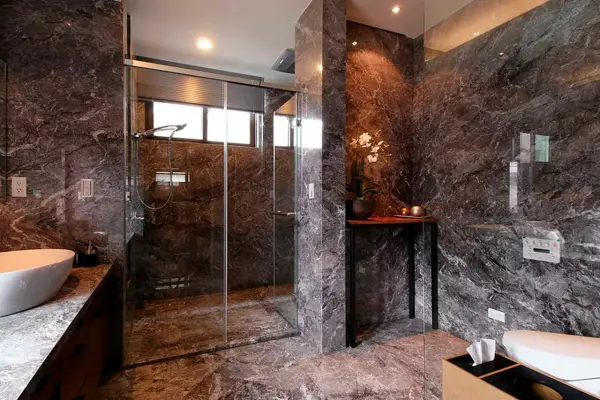Granite tile for home has long ceased to be a privilege of elite construction. In 2025, the cost of quality material has dropped to $35-45 per square meter, making natural stone accessible to the middle class. Granite tile is universal — suitable for both interior finishing of residential spaces and building exteriors where maximum resistance to weather conditions is required.
European quarries confidently enter the global market. Local stone quality meets international standards like Swiss clockwork — precision in every detail. From my experience, the right choice of surface treatment determines the service life of the coating for decades.
But what's the fundamental difference?
Granite Tile for Interiors: Sophistication in Details
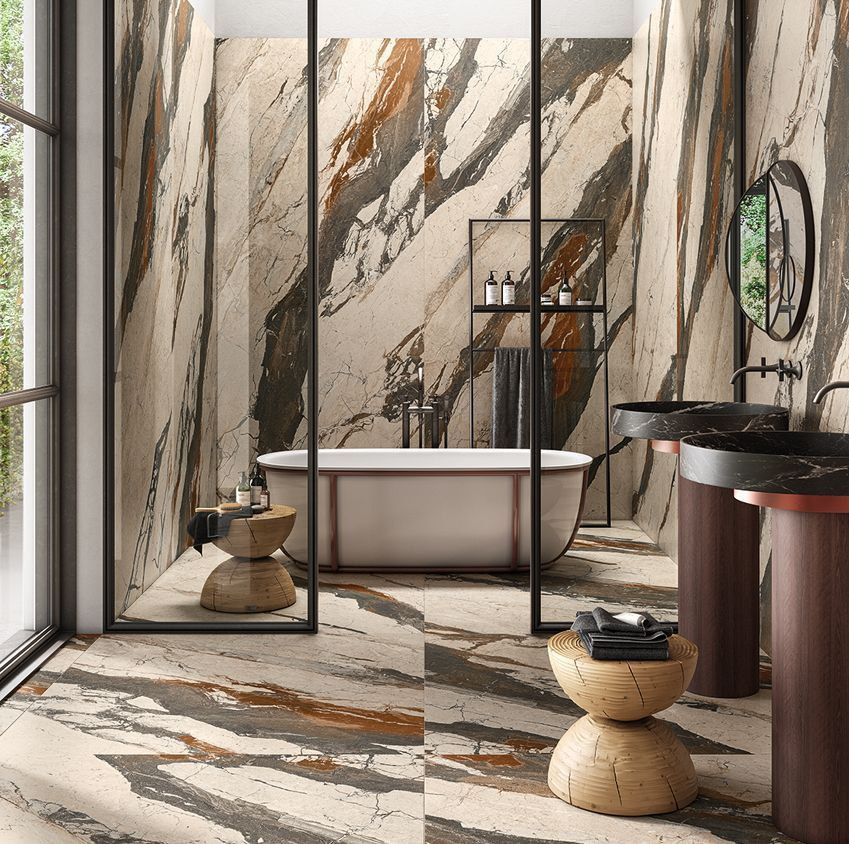 Beauty requires a special approach to material selection. Granite tile for home differs fundamentally from outdoor alternatives in surface treatment type. Interior options emphasize the aesthetic qualities of natural stone, highlighting the unique natural pattern of each slab.
Beauty requires a special approach to material selection. Granite tile for home differs fundamentally from outdoor alternatives in surface treatment type. Interior options emphasize the aesthetic qualities of natural stone, highlighting the unique natural pattern of each slab.
Polished Surface for Living Spaces
Mirror-like shine creates a sense of luxury in every room. Polished granite tile maximally reveals the stone's structure — every vein, inclusion, and color play. This treatment is ideal for granite floor tile in living rooms, hallways, and bedrooms where coating presentability is important.
At a London design bureau, I observed the installation of gabbro tile measuring 600×600 mm. The result amazed the client — the room visually increased in size, and every ray of light turned into a play of reflections. Honestly, polishing transforms an ordinary floor into a work of art that captivates guests.
Interior designer Elena Mitchell from StoneDesign studio notes: "Polished granite requires careful maintenance, but following simple rules preserves its pristine shine for 20-25 years without restoration."
Honed Granite Processing — Compromise Between Beauty and Practicality
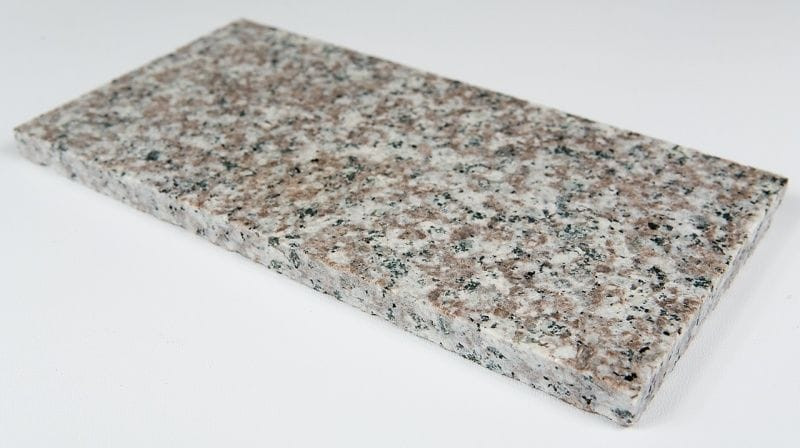 Matte noble shine without slip risk. Honed surface provides sufficient decorative appeal with increased safety. This treatment type is optimal for bathroom granite tile and kitchen granite tile, where aesthetics and functionality combine at the highest level.
Matte noble shine without slip risk. Honed surface provides sufficient decorative appeal with increased safety. This treatment type is optimal for bathroom granite tile and kitchen granite tile, where aesthetics and functionality combine at the highest level.
Water absorption of honed granite is less than 0.18%. This guarantees durability in high humidity conditions. The surface easily cleans from dirt and grease stains even after intensive use.
A comparison table will help determine the optimal treatment type for specific rooms considering operational specifics.
| Treatment Type | Interior Application | Maintenance Level | Price, $/m² |
|---|---|---|---|
| Polished | Living rooms, bedrooms, halls | High | 35-58 |
| Honed | Bathrooms, kitchens, corridors | Medium | 38-55 |
| Matte granite tile | Offices, libraries | Low | 30-48 |
| Sawn granite tile | Utility rooms | Minimal | 25-42 |
Treatment choice affects not only appearance but also long-term coating performance characteristics.
Granite Tile for Exteriors: When Strength is Priority
Outdoor conditions dictate harsh survival rules. Exterior tile must withstand temperature fluctuations, precipitation, mechanical loads, and UV radiation. Outdoor granite tile differs fundamentally from interior alternatives in surface treatment type — here functionality is more important than aesthetics, and safety supersedes beauty.
Thermal-Treated Surface — Safety Standard
Fire tempers stone character forever. Thermal-treated granite tile is achieved through gas torch exposure at temperatures exceeding 1000°C. The process creates a rough non-slip surface that prevents injuries on wet surfaces even in rainy weather.
The slip coefficient decreases 4 times compared to polished surface — a figure that saves lives. This is critically important for granite steps, terraces and patios, garden paths. Frost resistance of thermal-treated coating exceeds 400 freeze-thaw cycles — twice the requirements of European EN 12371 standards.
By the way, proper granite coating care extends service life by 15-20 years. Regular dry cleaning prevents accumulation of abrasive particles that gradually wear the surface.
Architect Michael Peterson from EuroArch bureau emphasizes: "For European climate, thermal treatment isn't luxury but necessity. Safety savings turn into injuries and lawsuits."
Bush-Hammered Surface for Maximum Loads
Special hammers create uniform textured surface with thousands of micro-indentations. Bush-hammered surface provides maximum grip with shoe soles or vehicle tires. This treatment is indispensable for paving driveways, squares, parking areas where safety allows no compromise.
Wear resistance of bush-hammered granite is twice that of polished. Last season I participated in a central square improvement project — the coating withstood intensive traffic without visible damage, as if time had no power over it.
Granite Tile for Facades: Prestige and Protection
Granite facade finishing is an investment in the future. Natural stone cladding protects walls from atmospheric influences and gives buildings a solid appearance. Anti-slip granite tile with bush-hammered treatment is ideal for ground floors and entrance groups.
Granite tile sizes for facades range from 300×600 mm to 600×1200 mm. Granite tile thickness for exterior application is 30-40 mm — this ensures reliable attachment and structural durability.
Color Range of European Granites: Natural Palette of Possibilities
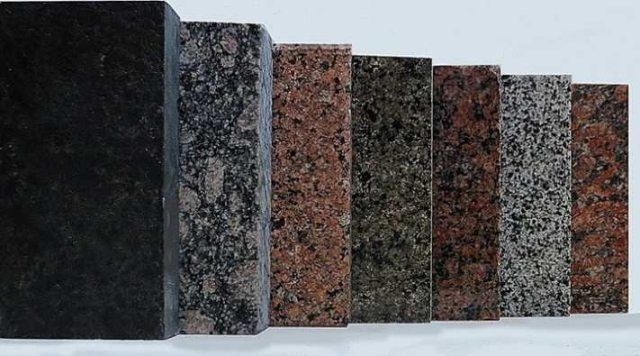 Europe offers impressive variety of shades for the most demanding projects. Gray granite from Scandinavian quarries — classic genre with fine-grained structure. Red granite from Italian deposits creates effective interior accents and impresses with color saturation.
Europe offers impressive variety of shades for the most demanding projects. Gray granite from Scandinavian quarries — classic genre with fine-grained structure. Red granite from Italian deposits creates effective interior accents and impresses with color saturation.
Black gabbro granite from Scottish quarries has mirror polish and noble shine like a starry night sky. Greenish labradorite shades give surfaces mysterious light play. Pink granite from Portuguese "Vale das Fontes" quarry enjoys growing demand in European projects thanks to unique warmth of shade.
What granite tile color to choose for a specific project? Light tones visually expand space and create airiness, dark ones form solidity and unshakeable prestige.
Decorative Possibilities of Modern Processing
21st century technologies expand the boundaries of possibility. Wood-look granite tile imitates noble wood textures while maintaining stone strength. Marble-look granite tile combines elegant marble veining with granite practicality — perfect combination of beauty and durability.
From my experience, such solutions are especially popular in modern apartment interior design with granite tile. Clients get luxurious appearance without complex maintenance of capricious marble.
Comparison with Alternative Materials
Flooring choice requires balanced decision. Comparing granite tile with main competitors helps make informed decisions.
Comprehensive characteristic comparison helps evaluate each material's advantages.
| Material | Service Life, years | Water Absorption, % | Price with Installation, $/m² | Maintenance |
|---|---|---|---|---|
| Granite tile | 80-100 | 0.1-0.3 | 55-95 | Minimal |
| Porcelain tile | 25-40 | 0.05-0.5 | 30-70 | Simple |
| Marble | 50-70 | 0.2-0.5 | 65-125 | Complex |
| Premium laminate | 12-18 | 8-12 | 35-85 | Medium |
When calculating 20-year ownership costs, granite proves the most economical solution.
Technical Features: Sizes, Thickness, Compatibility
Size matters for functionality. Granite tile dimensions for interior and exterior differ fundamentally. Indoor options more often have 300×300 mm or 400×400 mm format for creating more intimate atmosphere.
Outdoor formats reach 600×600 mm and larger. This provides fewer joints and increased coating strength. Granite tile thickness also depends on purpose: 15-20 mm for interiors, 30-50 mm for exteriors.
What granite tile thickness is needed specifically? By the way, many clients overpay for excessive thickness without understanding real load requirements.
Compatibility with Radiant Floor Heating
Granite works excellently with heating systems. Thermal conductivity coefficient 2.5-3.5 W/m·K ensures uniform surface warming. Maximum heating temperature shouldn't exceed 28°C according to EN 1264 standards.
When installing on heated floors, use elastic adhesives with thermal expansion compensation. Expansion joints every 6-8 meters prevent coating cracking.
Granite Tile Thickness Selection Criteria
Proper calculation saves budget:
- 15-20 mm — residential rooms, low-traffic offices
- 20-30 mm — kitchens, bathrooms, commercial spaces
- 30-40 mm — granite porches, terraces, balconies
- 40-60 mm — sidewalks, squares, pedestrian zones
- 60-80 mm — parking lots, driveways, industrial facilities
Underestimating loads leads to premature coating destruction and need for complete replacement.
European Granite Quarries: World-Class Quality
Europe is a major granite producer globally. Main quarries are located in Norway, Finland, Portugal, and Italy. European granite gradually conquers global markets thanks to compliance with international ISO 9001 standards and strict European EN 12440 norms.
Scandinavian Region — Industry Flagship
Norwegian quarries produce gray granite with fine-grained structure. Granite density reaches 2.65 g/cm³ with Mohs hardness of 6-7 points. Stone contains up to 68% quartz — ensuring exceptional granite strength and wear resistance.
Italian quarries are famous for red granite with unique decorative qualities. Material is exported to Germany, France, UK under trade mark "Italian Red".
European granite contains up to 68% quartz — ensuring exceptional strength and wear resistance according to EN 12440. Material meets European standard EN 12371 for frost resistance and strength characteristics.
Export Prospects for Granite Products
Global market opens new opportunities. In 2024, European granite export grew 28% despite challenging conditions. American buyers value stable quality, environmental purity, and competitive pricing of European stone.
Real story: "Two years ago our family decided to outfit our country house terrace. We chose thermal-treated tile from Portuguese quarries measuring 400×400×30 mm for $42/m². Local craftsman performed installation. Today the coating looks like new — no cracks, chips, or color loss. Neighbors regularly ask about the supplier." — Robert M., California
Practical Advantages: Why Choose Stone Coating
Savings begin after 5 years of operation and grow year by year. Choosing stone cladding for exteriors eliminates need for regular repair and painting due to seasonal changes. Granite wall tile doesn't require updates for decades — significant maintenance budget savings that pays back initial investment.
For interiors, advantages are similar and impressive. No need for repainting, re-plastering, repairing chips and cracks. Natural stone maintains original appearance with minimal care, like good wine — only improves with age.
Specific Savings Numbers
Payback calculation impresses even skeptics:
- Ceramic tile: replacement every 15-20 years, cost $12-25/m² + labor $15-20/m²
- Facade painting: renewal every 3-5 years, cost $8-15/m² + labor $10-18/m²
- Stone tile: replacement after 80-100 years, cost $35-65/m² + labor $20-35/m²
- 20-year operation savings: $70-120/m² compared to alternatives
Not to mention prestige and 8-12% property value increase. Honestly, investing in quality stone is investing in family's future.
Wholesale granite tile from European producers offers additional 15-25% savings for large projects. Granite tile delivery is performed by specialized transport meeting fragile cargo requirements — care at every stage.
By the way, many suppliers offer granite tile promotions during off-season and discounts for large orders. Environmental friendliness of finishing materials becomes important selection factor — granite is completely natural and health-safe.
Granite Technical Characteristics: Scientific Approach to Selection
Numbers determine coating fate for decades. Granite tile characteristics directly affect application area and durability. Granite compressive strength varies from 180 to 300 MPa — for comparison, C30 concrete withstands only 30 MPa.
Quality material water absorption is 0.1-0.3% — 20 times less than ceramic tile. Abrasion resistance is 0.1-0.4 g/cm², ensuring appearance preservation under intensive loads. Thermal expansion coefficient 8×10⁻⁶ 1/°C minimizes temperature deformations.
Durability impresses skeptics. Granite coating serves 80-100 years with proper installation technology — that's 4-5 family generations. For comparison: porcelain tile serves 25-40 years, laminate requires replacement every 8-12 years.
Practical Material Testing
Laboratory tests confirm stated characteristics. European granite samples from Norwegian quarries showed excellent results:
- Frost resistance: 420 cycles (standard F300)
- Flexural strength: 18-24 MPa (standard 12 MPa)
- Mohs hardness: 6.5-7.2 points
- Acid resistance: weight loss less than 0.1%
- Radioactivity: class A (safe for residential premises)
These indicators explain why global buyers choose European stone.
Granite Tile Installation Technology: Interior vs Exterior
Different conditions — different technologies according to EN 12004. Granite tile installation technology differs fundamentally for interior and exterior work. Indoor granite tile installation allows standard C2 class adhesive compositions, while outdoor coatings require frost-resistant C2S1 class solutions.
Interior Installation Features
Comfortable conditions simplify the process. Substrate preparation includes surface leveling with deviations no more than 2 mm per meter. Special granite adhesive is applied with notched trowel 8-10 mm tooth for thin tile.
Joints between tiles are 2-3 mm — this ensures thermal expansion compensation and neat appearance. Joint grouting is performed 24 hours after installation with special natural stone compositions.
Exterior Work Nuances
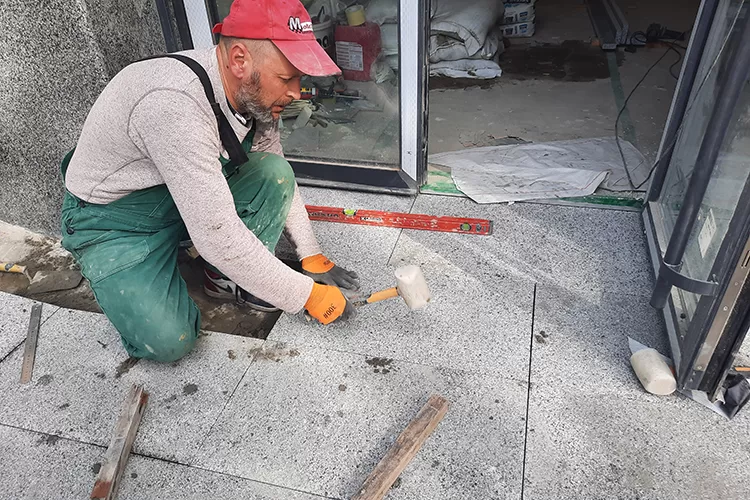 Outdoor conditions require reinforced solutions. Paving technology begins with crushed stone base 15-20 cm thick and sand cushion 5-10 cm. Reinforced screed 10 cm thick is mandatory for areas with vehicle traffic.
Outdoor conditions require reinforced solutions. Paving technology begins with crushed stone base 15-20 cm thick and sand cushion 5-10 cm. Reinforced screed 10 cm thick is mandatory for areas with vehicle traffic.
Drainage system prevents flooding and frost heaving. Adhesive composition must have frost resistance no less than F100 and adhesion to base over 1.5 MPa.
Practical Checklists for Granite Tile Buyers
What to Check During Material Acceptance
Proper acceptance eliminates installation problems:
- Size compliance with stated (tolerance ±1 mm per EN 12058)
- No cracks, chips, stains on face surface
- Color and structure uniformity throughout batch
- Quality certificate indicating quarry
- Radioactivity test protocol (class A)
- Proper packaging — protection from transport chips
Common Selection and Installation Mistakes
Forewarned is forearmed. Common mistakes lead to complete project rework:
- Underestimating thickness for loads — saving $8-15/m² turns into coating replacement
- Ignoring expansion joints — leads to winter tile buckling
- Using regular tile adhesive instead of stone-specific
- Installation without preliminary layout — asymmetric cuts spoil appearance
- Grouting with cement compositions — leaves permanent stains on polished surfaces
- Installation at temperatures below +5°C without antifreeze additives
Cost of correcting mistakes is 3-5 times higher than initial savings on materials or labor.
Application Areas: From Residential Homes to Public Spaces
Versatility is granite's key advantage. Natural stone flooring suits any premises — from cozy bedrooms to industrial workshops. Granite tile facade cladding gives buildings solid appearance and protects from atmospheric influences for decades.
Base finishing is classic architectural solution tested by centuries. Wall cladding creates accent surfaces in interiors. Path paving and entrance groups form first impression of house or office.
Public spaces require special approach — here wear resistance, safety, and easy maintenance are important. Granite paving stone withstands millions of steps without visible wear.
Daily Granite Care: Simple Longevity Rules
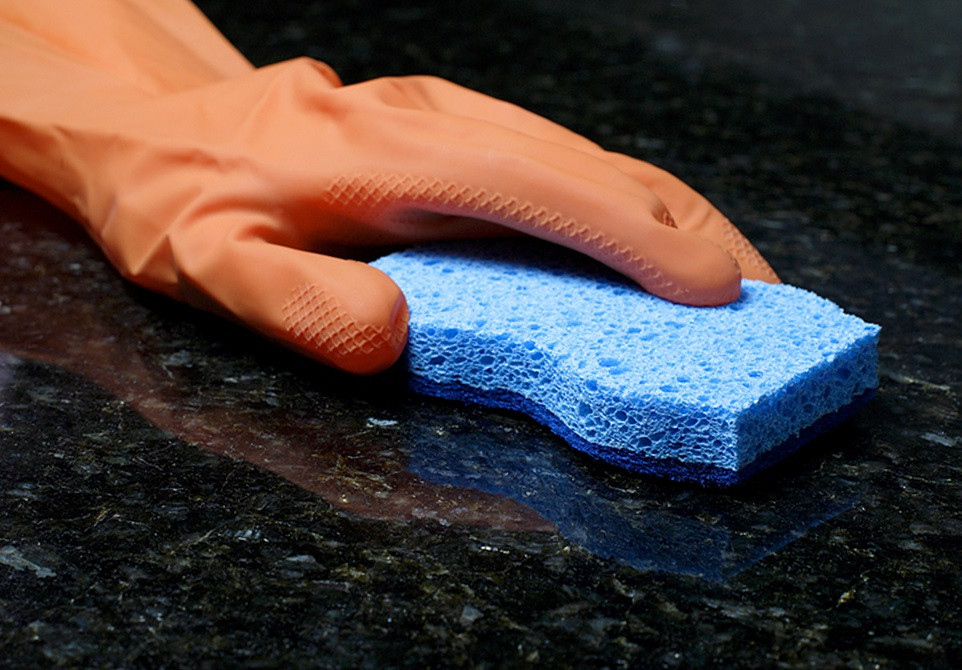 Proper care requires no special skills. Daily dry cleaning with vacuum or mop removes sand and dirt — main enemies of stone coating. Abrasive particles act like sandpaper, gradually wearing surface.
Proper care requires no special skills. Daily dry cleaning with vacuum or mop removes sand and dirt — main enemies of stone coating. Abrasive particles act like sandpaper, gradually wearing surface.
Entry mats reduce contamination by 70%. Weekly wet cleaning with neutral detergents maintains pristine appearance. For polished surfaces avoid acidic compositions — they permanently dull shine.
Professional polishing every 3-5 years restores mirror shine. Service cost $5-8/m², significantly cheaper than complete coating replacement.
